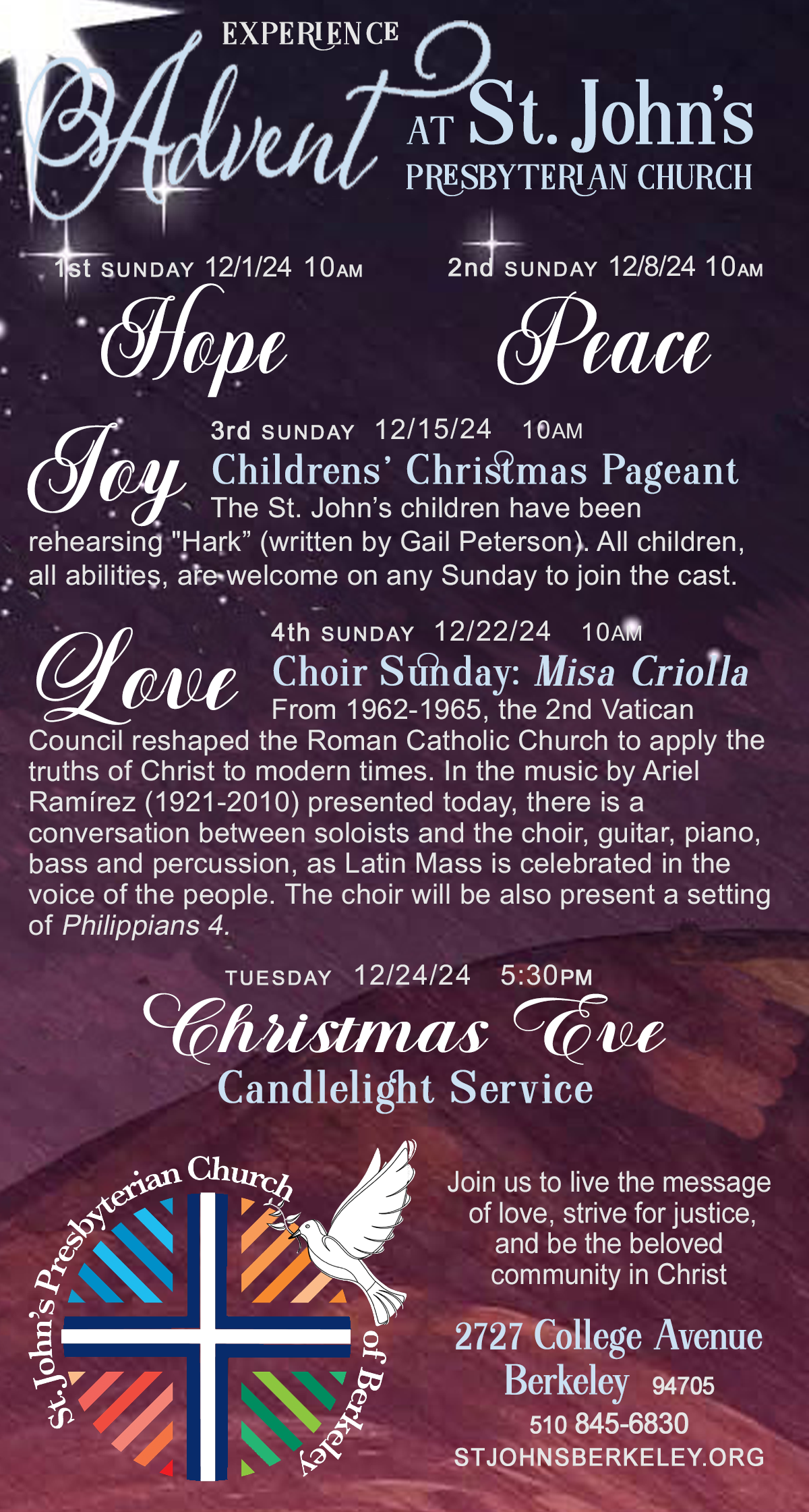
WE ARE CELEBRATING!
Every Sunday, 10am –– join us in person or through Zoom. Come as you are!
H o p e
Sunday, December 1 – 1st Sunday of Advent
10am … Includes Communion
P e a c e
Sunday, December 8 – 2nd Sunday of Advent
J o y
Sunday, December 15 – 3rd Sunday of Advent
10am … The Children’s Christmas Pageant!
The children of St. John’s have been rehearsing “Hark” and they are excited to present it to you. It is a Christmas play written by our own Gail Peterson with audience-singing participation. Two more rehearsals ahead: December 1 and December 8 – both following the service; New recruits welcome anytime.
All children, and their friends, are invited to participate in this festive annual event. Please don’t worry about attending all of the rehearsals –– we always can make room for one more shepherd, lamb or townsperson on the day of the pageant – come join the fun of performance!
Please contact me at church or through email if you need more details: Manju Noone, manju@stjohnsberkeley.org
L o v e
Sunday, December 22 – 4th Sunday of Advent
10am … Choir Sunday: Misa Criolla
From 1962-1965, the Second Vatican Council reshaped the Roman Catholic Church in order to apply the truths of Christ to modern times. Ariel Ramírez (1921-2010), an Argentine composer, embraced the notion that the mass should be celebrated in the language of the people. Ramirez crafted the traditional Latin mass, translated into Spanish, into a piece that uses the rhythms of Argentina and Bolivia, such as the vidala-baguala of the Kyrie and the carnaval cochabambino in the Sanctus.
A musical conversation between a small group of soloists and the choir overlays an instrumental ensemble consisting of guitar, piano, bass, and various percussion instruments.
Come to hear our own choir section leader, Shauna Fallihee, singing gorgeous duets with guest Aléxa Sessler, one of the Bay Area’s own fine operatic sopranos.
As an added treat, the choir will be presenting a setting of Philippians 4 by our own baritone member of the choir, John Geist. John describes the piece as more theatrical than choral, though there is plenty of beautiful lyricism in his work to engage listeners. Take advantage of the opportunity to hear this relatively new work. – The Reverend Todd Jolly
Christmas Eve
Tuesday, December 24
5:30pm … Candlelight Service .
Lessons and Carols highlight this beautiful evening service glowing with red poinsettias, candlelight and holiday music.

Subscribe to our Bulletin to get on the email list with information on meetings and services, both online and in-person. Click this link to subscribe.
FROM THE PRESBYTERIAN MISSION WEBSITE…

“Advent” means “coming” or “arrival.” During the season of Advent, we celebrate Christ’s coming into the world and watch with expectant hope for his coming again. In its historical origins, the season of Advent was patterned after the season of Lent, a six-week period of penitence and preparation for Easter. Similarly, the four weeks of Advent present an opportunity for communal discernment and personal examination, as the church prepares to celebrate the Nativity of the Lord and looks with hope for Christ’s return.
Between memory and hope
An excerpt from the Companion to the Book of Common Worship (Geneva Press, 2003, 96)
In Advent we expectantly wait for the One who has already come. We anticipate the promised justice of God’s new world, yet we praise God who raised the “righteous branch” to rule with justice and righteousness. We hope for the restoration of the afflicted, the tormented, and the grieving, yet we delight that healing has come in Christ. We long for the beating of swords into plowshares, yet we rejoice that the Prince of Peace has appeared. We yearn for the barren deserts of our inner cities to flourish, yet we laud the desert Rose that has bloomed. We dream of the land where lions and lambs live in harmony, yet we acclaim the child born to lead us into the promised land.
Christ has come! Christ is risen! Christ will come again! In Advent, we are living between the first and the second coming of the Lord. The dialectical tension of maranatha [alternately translated “Come, our Lord!” or “Our Lord has come”] — placing us between memory and hope, past and future — may strengthen our Advent liturgies. Perhaps we need to cling to the ancient cry of maranatha! and its paradoxical meanings so we may freely embrace “the new thing” prophesied by Isaiah (Isaiah 43:19) that God is doing among us right now. The tension and paradox we find in Advent shapes our celebrations during the season.
